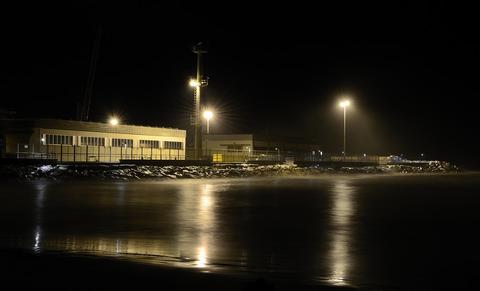当前位置:
X-MOL 学术
›
Funct. Ecol.
›
论文详情
Our official English website, www.x-mol.net, welcomes your
feedback! (Note: you will need to create a separate account there.)
Artificial light at night erases positive interactions across trophic levels
Functional Ecology ( IF 4.6 ) Pub Date : 2019-12-27 , DOI: 10.1111/1365-2435.13485 Elena Maggi 1 , Lucia Bongiorni 2 , Debora Fontanini 1 , Antonella Capocchi 1 , Martina Dal Bello 3 , Andrea Giacomelli 4 , Lisandro Benedetti‐Cecchi 1
Functional Ecology ( IF 4.6 ) Pub Date : 2019-12-27 , DOI: 10.1111/1365-2435.13485 Elena Maggi 1 , Lucia Bongiorni 2 , Debora Fontanini 1 , Antonella Capocchi 1 , Martina Dal Bello 3 , Andrea Giacomelli 4 , Lisandro Benedetti‐Cecchi 1
Affiliation

|
Artificial light at night (ALAN) is one of the most recently recognized sources of anthropogenic disturbance, with potentially severe effects on biological systems that are still to be fully explored. Among marine ecosystems, high‐shore habitats are those more likely to be impacted by ALAN, due to a more intense exposition to outdoor nocturnal lightings (mostly from lamps along coastal streets and promenades, or within harbours, ports and marinas). By performing in situ nocturnal manipulations of a direct source of white LED light and presence of herbivores in a Mediterranean high‐shore habitat, we assessed the interactive effects of light pollution and grazing on two key functional components of the epilithic microbial community (the cyanobacteria, as the main photoautotrophic component, and the other bacteria, mainly dominated by heterotrophs) developing on rocky shores. Results showed an unexpected increase in the diversity of epilithic bacterial biofilm at unlit sites in the presence of grazers, that was more evident on the other (mainly heterotrophic) bacterial component, when giving weight to more abundant families. This effect was likely related to the mechanical removal of dead cells through the grazing activity of consumers. ALAN significantly modified this scenario, by reducing the density of grazers and thus erasing their effects on bacteria, and by increasing the diversity of more abundant cyanobacterial families. Overall, direct and indirect effects on ALAN resulted in a significant increase in the diversity of the photoautotrophic component and a decrease in the heterotrophic one, likely affecting key ecosystem functions acting on rocky shore habitats. ALAN may represent a threat for natural systems through the annihilation of positive interactions across trophic levels, potentially impairing the relationship between biodiversity and functioning of ecosystems and interacting with other global and local stressors currently impinging on coastal areas. A free Plain Language Summary can be found within the Supporting Information of this article.
中文翻译:

夜间人造光消除了营养级之间的积极相互作用
夜间人造光 (ALAN) 是最近公认的人为干扰源之一,对生物系统有潜在的严重影响,仍有待充分探索。在海洋生态系统中,高岸栖息地更容易受到 ALAN 的影响,因为对室外夜间照明(主要来自沿海街道和长廊,或港口、港口和码头内的灯)的照射更为强烈。通过对直接白光 LED 光源和地中海沿岸栖息地中食草动物的存在进行原位夜间操作,我们评估了光污染和放牧对附生微生物群落的两个关键功能成分(蓝藻、作为主要的光合自养成分,其他细菌,主要以异养生物为主)在岩石海岸上发育。结果显示,在有食草动物存在的情况下,未发光部位的附生细菌生物膜的多样性出乎意料地增加,这在其他(主要是异养的)细菌成分上更为明显,当赋予更丰富的家庭权重时。这种效果可能与通过消费者的放牧活动机械去除死细胞有关。ALAN 通过降低食草动物的密度从而消除它们对细菌的影响,以及增加更丰富的蓝藻家族的多样性,显着改变了这种情况。总体而言,对 ALAN 的直接和间接影响导致光合自养组分多样性的显着增加和异养组分多样性的减少,可能影响作用于岩石海岸栖息地的关键生态系统功能。ALAN 可能通过消除跨营养级的积极相互作用对自然系统构成威胁,可能损害生物多样性与生态系统功能之间的关系,并与目前影响沿海地区的其他全球和地方压力因素相互作用。可以在本文的支持信息中找到免费的普通语言摘要。
更新日期:2019-12-27
中文翻译:

夜间人造光消除了营养级之间的积极相互作用
夜间人造光 (ALAN) 是最近公认的人为干扰源之一,对生物系统有潜在的严重影响,仍有待充分探索。在海洋生态系统中,高岸栖息地更容易受到 ALAN 的影响,因为对室外夜间照明(主要来自沿海街道和长廊,或港口、港口和码头内的灯)的照射更为强烈。通过对直接白光 LED 光源和地中海沿岸栖息地中食草动物的存在进行原位夜间操作,我们评估了光污染和放牧对附生微生物群落的两个关键功能成分(蓝藻、作为主要的光合自养成分,其他细菌,主要以异养生物为主)在岩石海岸上发育。结果显示,在有食草动物存在的情况下,未发光部位的附生细菌生物膜的多样性出乎意料地增加,这在其他(主要是异养的)细菌成分上更为明显,当赋予更丰富的家庭权重时。这种效果可能与通过消费者的放牧活动机械去除死细胞有关。ALAN 通过降低食草动物的密度从而消除它们对细菌的影响,以及增加更丰富的蓝藻家族的多样性,显着改变了这种情况。总体而言,对 ALAN 的直接和间接影响导致光合自养组分多样性的显着增加和异养组分多样性的减少,可能影响作用于岩石海岸栖息地的关键生态系统功能。ALAN 可能通过消除跨营养级的积极相互作用对自然系统构成威胁,可能损害生物多样性与生态系统功能之间的关系,并与目前影响沿海地区的其他全球和地方压力因素相互作用。可以在本文的支持信息中找到免费的普通语言摘要。











































 京公网安备 11010802027423号
京公网安备 11010802027423号